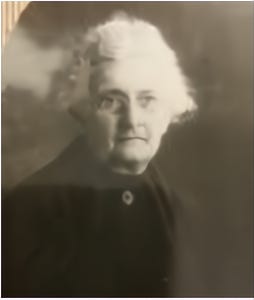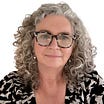Our guest writer,
ofjoins us as part of our first cohort in the Projectkin Members’ Corner. Monthly posts from members celebrate their contributions to family history storytelling — in all its forms. Posts may be written or recorded (audio or video) will be shared for free each month. Explore the entire Members’ Corner here.
Where were the women?
As I was growing up, I liked learning about history. In 1970, I was in 5th grade and jumped into American History with both feet. I learned about explorers, the Pilgrims, and pioneers. As a ten-year-old, I thought based on what I was taught from the textbooks, that men were the only people who existed in America.
My experience was that women were not mentioned in school history textbooks. The exception was Betsy Ross, the token woman who brought her sewing skills to the table of rugged individualists establishing America. I thought about how she must be lonely being the only woman in America. My ten-year-old mind pictured all the men coming to America and the women staying in Europe. I mean, if there were women there, they would have been included in the textbooks, right?

In all fairness, I do remember learning about Harriet Tubman and clinging to her story because she was a woman. Two women. That is it.
Later, in high school, feminism was on the rise, but there were still no changes in my textbooks. By then, I knew there were women in America, but as far as I could tell, they didn’t do anything of any significance. This was again, based on what I was reading in the textbooks.
Fast forward to 1994. I am 34 years old and have returned to college. I decided to take a Women’s History class. It might be interesting to learn about a few women who might have played a part in American history. I go to the bookstore to pick up my textbooks for the semester. The cafeteria is right next door. I grab a coffee and sit down with my new text-filled treasures. I open the book with essays about women in history.
Oh, my goodness! What?
Essay after essay about women who played major roles in the development of the United States appeared as I flipped through the pages. Wait. There were this many women? I began to feel great about the women who were people I could relate to and at the same time, felt resentment that I was just now finding out about them.
I showed up early to get a good seat on the first day of my Women’s History class. That’s what you do as an eager thirtysomething student. On that day, the teacher changed my entire understanding of women and their roles in history. I found out that the women were actually there in history in a significant way, but had been invisible in my early education. I fell deeply in love with history during that class. That semester I changed my major to U.S. History.
I can still remember the woman who I chose to write my report about, Ida B. Wells. Her strength, intelligence, and significance inspired me. Where was her story when I was 10 years old? What would my conceptual understanding of the world have been like if I had grown up knowing about women like her?
Fast forward to 1999.
I become a 5th grade teacher. One of the subjects I get to teach is U.S. History! This brings me great joy. I am a brand new teacher filled with that beautiful feeling of being able to fill children’s minds with knowledge. I open my teacher’s edition of the U.S. History textbook with a mixture of excitement and anticipation of the content that I will use to create a love of history for all my lovely 10-year-old students. Wait. What? Where are the women? Are you kidding me?
Oh heck no!
On that day, I started writing my supplemental curriculum that most definitely included women. By the time I retired in 2020, there had been some movement in the curriculum to be more inclusive, but of course, more is needed.
Now, it is 2024 and I spend as much time as possible researching and writing about my family history. I love that I have a history about my Hinkson family line that has been written about by my great-granduncle and others of his generation. It has given me an incredible foundation to build upon.
Guess who I am focusing on when I write my family history narrative? No. It is not a woman, but a man. I say this with my head hung low. What am I doing?
The research on Richard Summers Hinkson my 2-times great grandfather comes much more easily than it does for Mary Frances Sharp Hinkson, my 2-times great grandmother, because that is how history has been written. Don’t get me wrong. I love learning about Richard Summers Hinkson, but again, I ask. What am I doing? I’m making Mary Frances Sharp Hinkson invisible! Ugh.
A New Mindset
Enough of that. Mary Frances Sharp at the very least deserves equal billing in my family history narrative. With this new mindset, I got out my pen and paper, sat in my comfy chair and started writing.

Mary Frances Sharp was born in Turkey Creek, Benton County, Missouri on October 12, 1850. Mary was the 2nd child of John Sharp and Amanda McCall. The Sharps were from Virginia and the McCalls were from Georgia. Mary’s siblings included Leonard Ballou Sharp, Sarah Sharp, Elizabeth Sharp, Thomas Jefferson Sharp, and Samuel Madison Sharp. Mary wed Richard Summers Hinkson on June 21, 1868, in Amador County, California.
Writing by hand always makes me drowsy. I set down my pen and lay my head back for a moment. I am soon woken by a voice. I open my eyes and across from me seated on a wooden rocking chair that I don’t remember ever being there before is my 2-times great grandmother, Mary Frances Sharp Hinkson. For a moment, I am disoriented and I don’t hear what she is saying.
“Child, are you listening?” she says leaning toward me.

I sit up straight. “Yes, I am,” I answer. I realize that I am about to hear from Mary herself. I am excited and reach down to grab my pen to take notes. I can’t find the pen or the paper anywhere. It is too important to worry about taking notes. I would just have to remember everything she said. Here is her story.
Mary Frances Sharp Hinkson’s Story
I was the first to smell smoke. Our two-story house was the only one for miles in a place called Delhi. Our land bordered on one side along the Merced River. We had all just sat down at the table to eat supper. Richard sat opposite me at the other end of the table. Budd, John and Frank sat on one side. They were all grown men by then. My daughters, Jessie, and Eva, my son Louis, and my granddaughter Patricia, sat across from them. Patricia was about 5 years old then. The smoke confused me at first. The smell wasn’t coming from the kitchen. It seemed to be outside.
I set my fork down. “Richard, I smell smoke,” I said as I got up from the table. Richard set his fork down too. He pushed his chair back, got up, brushed past me and went to the back door. I heard the wooden screen slam behind him as he pushed through it to get outside. Richard came back in through the door. His eyes were wide and alarmed.
“A spark ignited the roof shingles,” he announced. He told everyone to get out of the house.
“Eva, take Patricia to the tree away from the house and stay with her,” I said.
“Yes Mama,” Eva answered as she held out her hand for Patricia and made her way out the door. Budd grabbed his shotguns out of the room off the kitchen and then held the door while we all left our house. We all were out in a few seconds.
Richard, Budd, John, Frank, Louis, Jessie, and I all ran for buckets in the barn. By the time we were able to get some water into those buckets, the whole house was on fire. We formed a line and quickly passed the buckets to each other from the well to Richard. He threw each bucket of water at the flames that were lapping up our two-story house. Our efforts and our buckets of water made no difference. The rage of the fire that was taking our home was winning. Finally, all we could do was stand in disbelief, watching. In what seemed like a blink of an eye, our house was a smoldering pile of black ashes.
It wasn’t until a few days later that I realized that all the pieces of furniture, my spinning wheel, clothing, and many things my family had brought from Virginia, and Richard’s family brought from Missouri were all gone. We lost every material thing we owned but the clothes on our backs. But by the grace of God, we all got out safely. Now, all I had left of those family treasures in our attic were my memories.
❦ — ❦ — ❦
I was 9 years old the year we left our farm in Missouri to come to California. Papa said that there was plenty of land there and we would have an adventure crossing the plains in our covered wagon. So all of us, Mama, Papa, my brothers, Bill and Thomas, my sisters, Sarah and Elizabeth, and I were to leave the life we knew, gather very few of our belongings, and head to California.
Mama didn’t want to leave Missouri, but she went along with Papa’s plan. Papa was always in charge and Mama didn’t question him. Mama was like that. She had been bound to a Mr. John Potter as a housekeeping apprentice when she was 11 years old. Her Papa had died. Mama and all her brothers were awarded by the court to become apprentices to different families. I’m not sure what happened to Mama’s mother. She never spoke of her. The only brother who was also bound to John Potter was her little brother, Wilson. I think my mama was just so happy to have a family, none of the details mattered to her. So she was always quite agreeable.
To me, the trip didn’t feel like the adventure Papa had promised. It was hard. We walked every day for many miles. It took us almost half a year to get to California.
When we first got to California, we lived in a place called Elliott. It was the year 1859 and Mama and Papa found us some land and built us a small house. We started farming but soon left to live in the foothills. We lived in Drytown for a spell, then moved to Fiddletown which was in an area Papa named the Shenandoah Valley. It was a lovely place in the hills of California.
Unlike my mama, I was inclined to have more of an opinion in my marriage. My husband, Richard called me “the Boss.” Everyone thought he was joking, but in our marriage, Richard was in charge of worldly matters such as work, community, and politics. When he would come home from everything happening out in the world, I was the one in charge at home. Richard knew it and so did our children…
I start to blink. Mary is drifting away. I open my eyes fully. I am here on my comfy chair. The wooden rocking chair and Mary are gone. I look down and my pen and paper are on my lap. No! I quickly shut my eyes. Come back, Mary! Please come back! Nothing. My heart sinks a little. I miss her already. I have so many questions. I grab my pen and start writing everything I remember from her story.
Do you think you might be interested in joining us here in the Members’ Corner with a piece of your own? We’d love to share your work. Learn more:









Great story. I'm waiting for the next piece of this adventure.
A lovely story Robin, you've really brought her to life and make me want to find out more about my own great grandmothers further back...